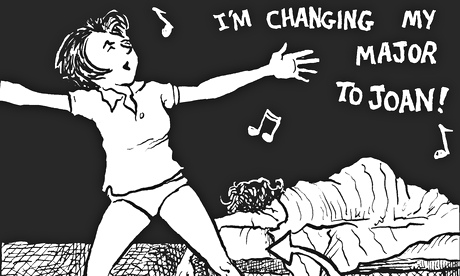
I don't remember where I first saw Alison Bechdel's Dykes to Watch Out For – it would have been in the 1980s, in any one of the alternative newspapers that I read in any one of the cities I lived in during my 20s. I had grown up in a comic-strip home – by which I mean, a house with many anthologies of comic strips, notably Peanuts, Doonesbury, Li'l Abner, and my favourite, Pogo, as well as a house and family full of eccentrics who were fond of punchlines. I had always loved the comic strips that my family loved, the way we could talk about Lucy van Pelt or Mammy Yokum or Miz Beaver and know we were discussing actual personalities who existed over years. A comic strip that your parents read when they were young is a curious thing: it's an heirloom and it's also intimate. You peer through windows and look at the things that made your elders laugh, and then you wonder whether the laugh really belongs to you.
Dykes to Watch Out For was entirely mine, even though it belonged to everyone who read it. It followed a group of people, mostly lesbians, who paired up and broke up and were dear friends and looked after each other. It seemed extraordinarily sophisticated to me – the characters seemed like fascinating grownups in the years when I was trying to figure out how to be a grownup, though now when I read it I see how wonderfully and realistically awkward they are; funny in the way that human beings are funny, sometimes breezily and sometimes heartbreakingly.
It turned out that Bechdel wasn't just brilliant at the serial form. In 2006, she published her graphic memoir Fun Home, a book about the life and death of her funeral director father, and then Are You My Mother?, about her relationship with her mother. There are no books like them anywhere.
Bechdel's art is beautiful, exact but also familiar: it feels, for want of a better word, homey, even as you read about inexplicable things – death, suicide, anger and the tyranny of family secrets . A Bechdel panel is full of information, and furniture, and oriental rugs, and the characters' shrugging postures, wry expressions and idiosyncratic turns of phrase. Some graphic narrative art presses against the panel: you wrestle with it at the level of the paper. Bechdel characters, drawing and ideas invite you in. Her work offers you a place to sit, even if it's an uncomfortable Victorian armchair; it allows you to look at the characters straight in the face; it lets them talk at length. Like all great art, Bechdel's says that the work of understanding each other is difficult, and necessary: the best work there is.
• Dykes to Watch Out For is published by Jonathan Cape

